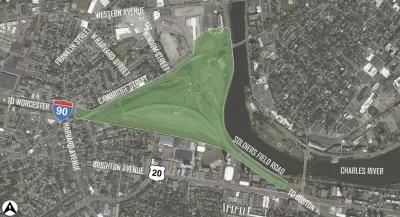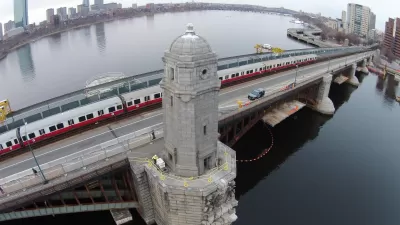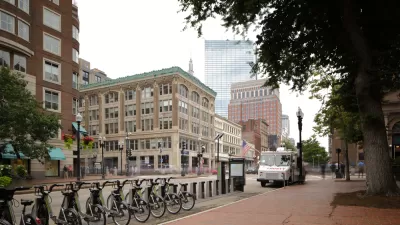Massachusetts Department of Transportation plans to heighten and widen the Allston section of I-90 viaduct do not align with the community's desire for an environmentally friendly and pedestrian- and cycling-oriented new solution.

The Allston section of I-90, a stretch of viaduct wedged between Boston University and the Charles River, was opened 55 years ago. The highway constitution project bisected a lower-income community and damaged riverfront habitat. Boston, Brookline, and Cambridge are still paying the price for what Bradley Campbell and Richard Dimino call "failed transportation policy that placed a highway above the needs of neighborhoods and the environment."
Now the viaduct needs to be replaced. "Nearly all stakeholders, including the city of Boston, agree that we should pursue a strategy for I-90 that plans for our future transportation needs, not reprise last-century’s failed approaches to create a new, bigger viaduct," write Campbell and Dimino.
Still, MassDOT's “Modified Highway Viaduct” option takes that very approach, heightening and widening the viaduct.
Campbell and Dimino stress that better options exist. A Better City, led by Dimino, has proposed an at-grade design that adds trees and a living shoreline to the pedestrian and bike access space running along the river. "This improved surface option is also designed to ensure that two-track commuter rail service on the Worcester Line remains in service during construction," they say.
Governor Charlie Barker should step up and give "Boston and the region a western gateway equal to its aspirations as a leader in urban design, transportation vision, and environmental planning," Campbell and Dimino assert.
FULL STORY: A new, bigger I-90 viaduct is not the answer

Maui's Vacation Rental Debate Turns Ugly
Verbal attacks, misinformation campaigns and fistfights plague a high-stakes debate to convert thousands of vacation rentals into long-term housing.

Planetizen Federal Action Tracker
A weekly monitor of how Trump’s orders and actions are impacting planners and planning in America.

In Urban Planning, AI Prompting Could be the New Design Thinking
Creativity has long been key to great urban design. What if we see AI as our new creative partner?

Pedestrian Deaths Drop, Remain Twice as High as in 2009
Fatalities declined by 4 percent in 2024, but the U.S. is still nowhere close to ‘Vision Zero.’

King County Supportive Housing Program Offers Hope for Unhoused Residents
The county is taking a ‘Housing First’ approach that prioritizes getting people into housing, then offering wraparound supportive services.

Researchers Use AI to Get Clearer Picture of US Housing
Analysts are using artificial intelligence to supercharge their research by allowing them to comb through data faster. Though these AI tools can be error prone, they save time and housing researchers are optimistic about the future.
Urban Design for Planners 1: Software Tools
This six-course series explores essential urban design concepts using open source software and equips planners with the tools they need to participate fully in the urban design process.
Planning for Universal Design
Learn the tools for implementing Universal Design in planning regulations.
planning NEXT
Appalachian Highlands Housing Partners
Mpact (founded as Rail~Volution)
City of Camden Redevelopment Agency
City of Astoria
City of Portland
City of Laramie




























